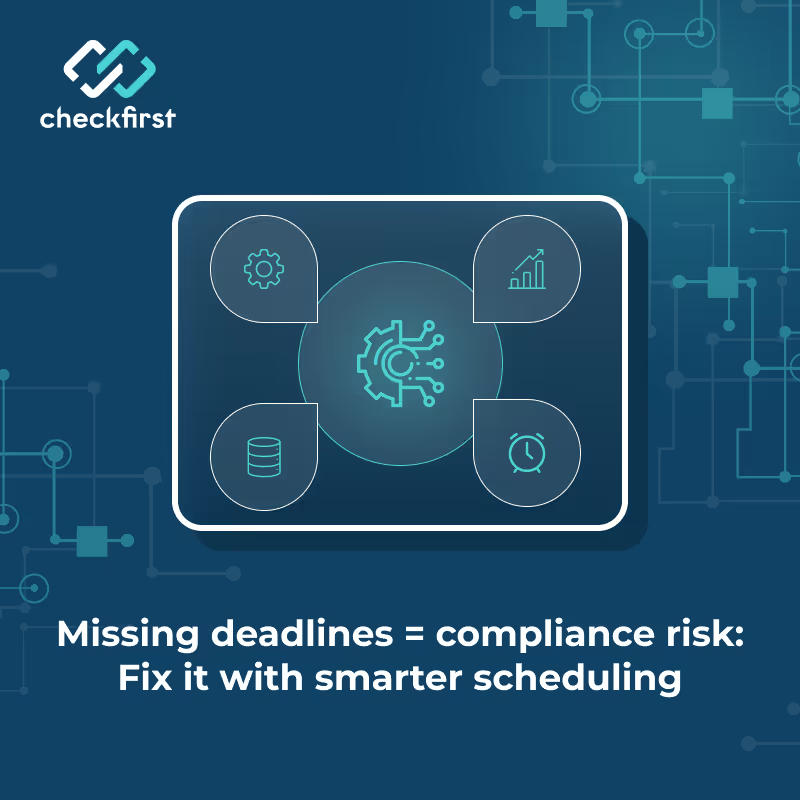



Missing audit deadlines creates risk you can’t ignore. Late visits, expired credentials, and messy reschedules drive findings and unhappy clients. In this blog, we’ll explore why deadlines slip in TICC, what “compliance-ready” planning looks like, and how AI helps you prevent errors before they happen.
You’ll see results from actual deployments and a quick path to value with ScheduleAI, a purpose-built scheduling software for certification and inspection teams.
Late or non-compliant assignments can trigger nonconformities and rework. Deadline breaches raise accreditation risk when rotation rules or credential expiries are missed. Margins suffer as subcontractor use rises and travel grows.
Planners burn out, and workload exceeds sustainable levels. Most of this stems from spreadsheets, scattered calendars, and manual routing - exactly the gaps AI was designed to close.
Related Post: The hidden cost of manual scheduling: A look at time, errors & missed coverage
Systemic issues in scheduling audits create operational inefficiencies, compliance, and resource management problems in organizations that affect certification activities.
Related Post: AI scheduling for planners & coordinators: Save hours, simplify workflows
Compliance isn’t a report; it’s your plan. A TICC-grade AI audit scheduling software can block non-compliant assignments before they go live. It enforces credential validity, scheme fit, rotation rules, and blackout dates.
It prioritizes due windows, applies explainable logic, and tracks a full audit trail. Live KPIs show on-time rate, lead times, reschedule rate, utilization, and travel load - so you manage by exception.
Intelligent automation transforms traditional scheduling approaches by embedding regulatory requirements directly into the planning process and decision-making workflows.
Related Post: Compliance & QA leaders’ secret to perfect audit scheduling: How ScheduleAI verifies every qualification
Generic audit scheduling solutions don’t handle 20+ allocation parameters across ISO, BRCGS, ESG, FSSC, GlobalG.A.P., and GMP+. ScheduleAI does. It matches by skills, rotation, language, region, day rates, and internal versus subcontractor rules.
The solution offers instant rescheduling, live utilization, and travel dashboards, as well as extensive APIs for Outlook, Google, Excel, and enterprise systems. The strong security protocols encompass ISO 27001, GDPR compliance, role-based access, full audit logging, and more.
Proof from the field:
The benefits of audit scheduling software are numerous if it’s purpose-built for the TICC industry. The advanced scheduling platform from Checkfirst integrates multiple compliance mechanisms to create a comprehensive framework that prevents violations and ensures accountability.
Related Post: Why ScheduleAI is the best scheduling software for TICC companies in 2025
Most teams start with a short proof of concept. Use your real audits, calendars, and holidays. Invite two or three planners into a sandbox.
Run AI allocation and measure coverage, utilization, travel, and admin time saved. Iterate weekly, then roll out. ScheduleAI integrates with your calendars, file storage, and systems, so teams keep familiar workflows while gaining control.
To measure performance, there must be certain metrics that give one visibility on the effectiveness of the schedules, the effective optimization of resources, as well as the regulatory adherence to all the operations.
Missed deadlines come from fragmented tools, complex rules, and constant rescheduling. The fix is preventive control in your plan. Purpose-built scheduling software blocks non-compliant assignments, explains decisions, and gives you live KPIs.
You saw how teams cut planning to minutes, raised utilization, and reduced travel. And, in case, you’re also willing to safeguard deadlines and margins with AI-based scheduling, reach out to Checkfirst to begin with a proof of concept and get impressive results.
Scheduling software helps you hit audit windows by enforcing rules, matching qualified auditors, reducing travel, and rescheduling safely. You see risks and prevent deadline breaches.
ScheduleAI is built for certification and inspection. The audit scheduling software for compliance enforces rotation, credential expiry, language, and blackout rules, auto-assigns audits fast, optimizes travel, and explains matches clearly.
By matching the right skills to the right audits, reducing idle gaps, clustering routes, and using internal teams first, utilization rises while subcontractor dependence drops.
It enforces credential validity, scheme fit, rotation spacing, language needs, coverage, public holidays, blackout windows, and due dates, then blocks non-compliant assignments and logs decisions.
Of course, there’s built-in security with ISO 27001 certification criteria, complete GDPR compliance, user permission by roles, end-to-end encryption, and audit trails. All the assignments and changes in the system are duly logged, hence, providing transparency in the compliance audit or incident investigation.